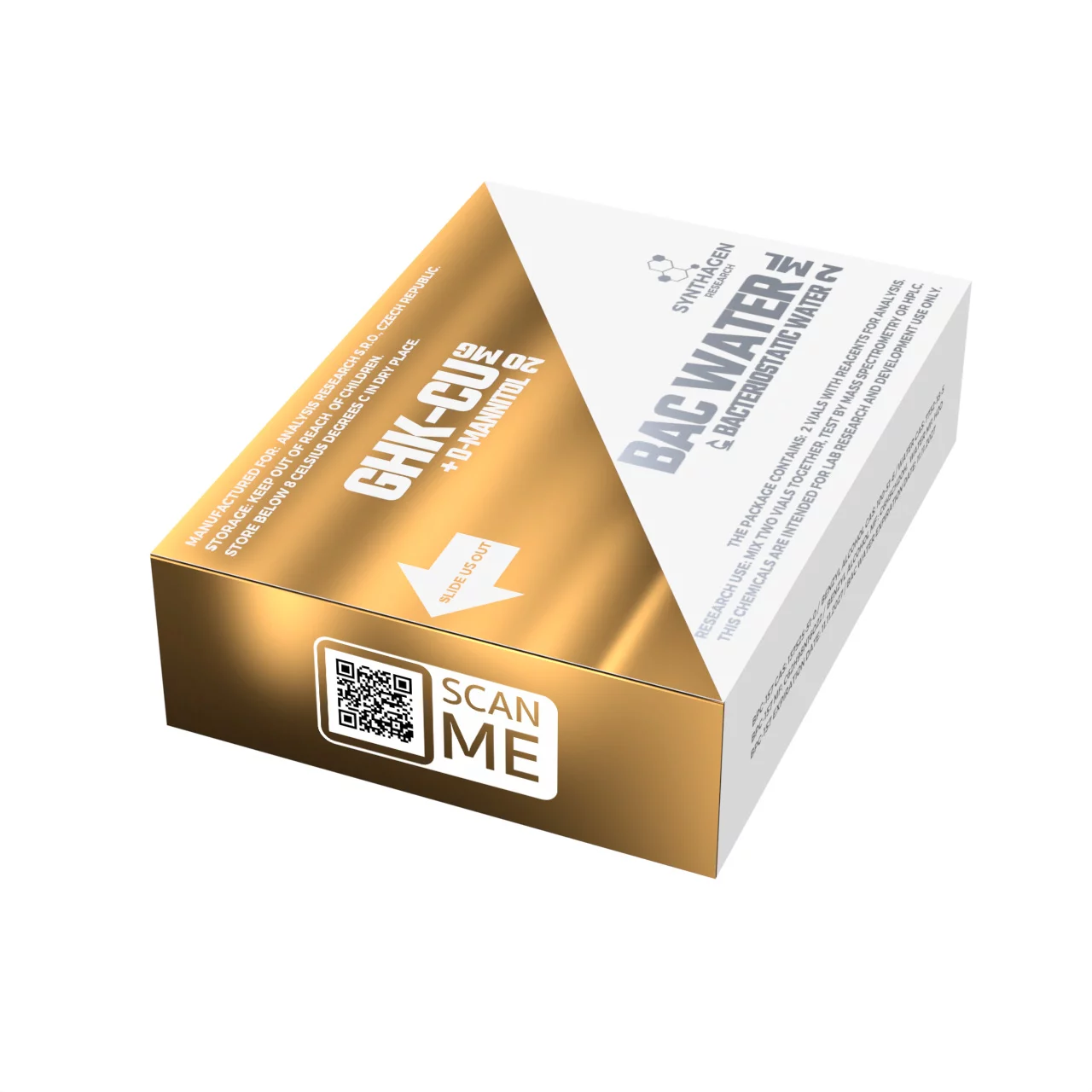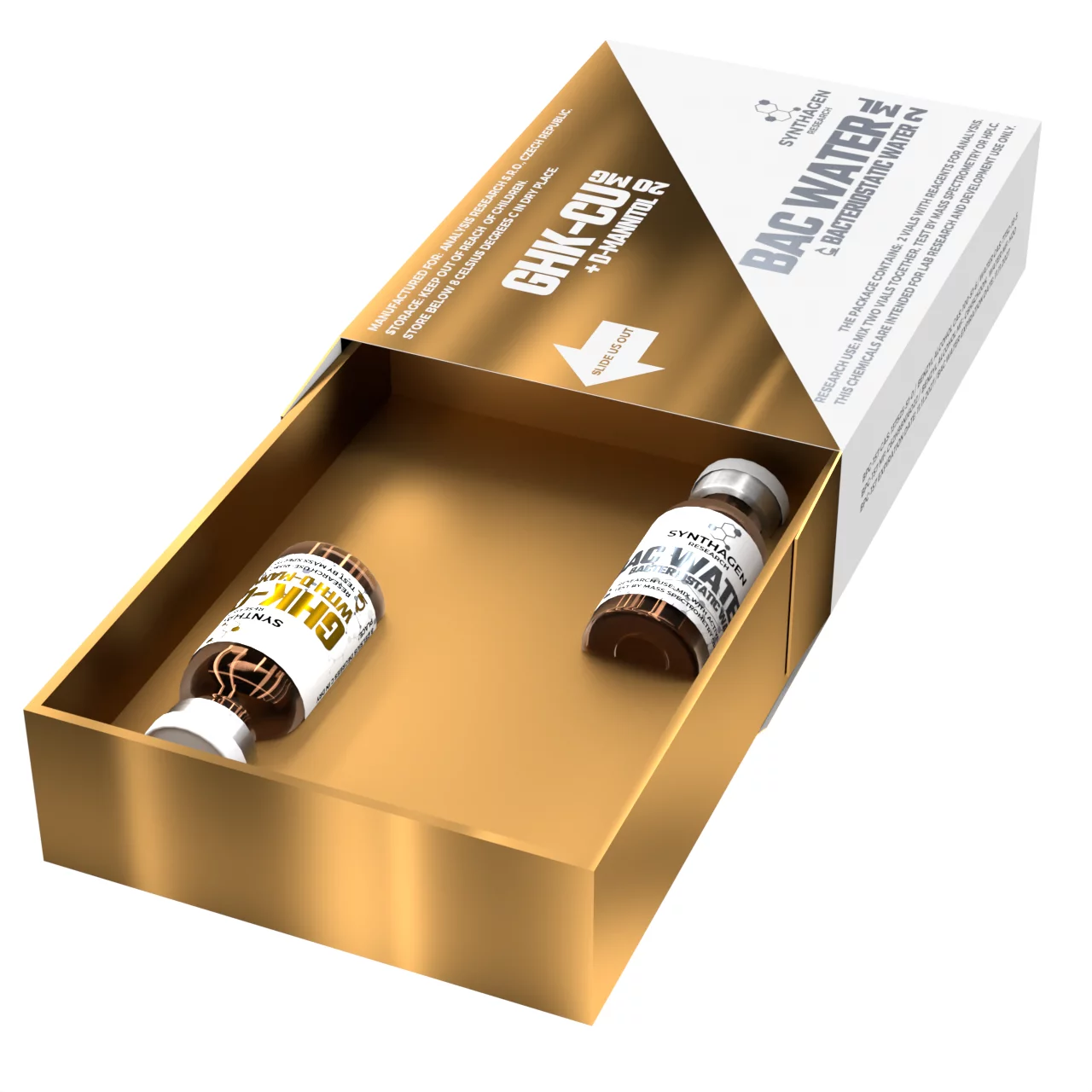GHK-Cu PROMOTES REGENERATION AND PROTECTION THROUGH:
- Activation of collagen and elastin synthesis — stimulates fibroblasts to renew skin, muscle, and connective tissue.
- Antioxidant action — neutralizes free radicals and protects DNA from oxidative stress.
- Regulation of inflammatory response — reduces inflammation and accelerates healing.
- Stimulation of angiogenesis — promotes new blood vessel formation and improves microcirculation.
- Support for hair growth — activates hair follicle stem cells and enhances keratin production.
💡 Effect: Firmer, more elastic skin, faster recovery after injuries and procedures, and visibly improved hair and tissue vitality.


PEPTIDE STRUCTURE — GHK-Cu
- Amino acid sequence: Gly-His-Lys
- Molecular formula: C₁₄H₂₄N₆O₄ + Cu²⁺
- Molecular weight: 340.88 g/mol (excluding copper ion)
- Form: Blue lyophilized powder (the distinct color results from copper complexation), readily soluble in water

RESEARCH & BIOLOGICAL ACTIVITY
GHK-Cu and Skin Regeneration
GHK-Cu stimulates fibroblasts to increase production of collagen, elastin, and glycosaminoglycans, improving skin structure and elasticity.
Clinical studies show significant improvement in skin density, wrinkle reduction, and accelerated repair of microdamage.
GHK-Cu and the Nervous System
The peptide exhibits neuroprotective properties — supporting neuron regeneration and reducing oxidative stress in neural cells.
Research suggests potential benefits for cognitive performance and neural recovery after central nervous system injury.
GHK-Cu and Tissue / Muscle Regeneration
GHK-Cu promotes fibroblast and stem cell proliferation, accelerating repair of muscles, tendons, and capillary networks.
In vivo models demonstrate shortened healing times and improved collagen type I and III integration in injured tissues.
GHK-Cu and Hair Growth
The peptide activates genes involved in follicular regeneration and the anagen (growth) phase of the hair cycle.
Clinical studies report increased hair density and prolonged growth phases following GHK-Cu application.
GHK-Cu, Oxidative Stress, and Cellular Aging
GHK-Cu enhances the activity of antioxidant enzymes such as SOD, catalase, and ceruloplasmin, protecting cells from oxidative damage.
It supports gene expression involved in DNA repair, contributing to slower cellular aging and extended cell lifespan.

Figure 1. Cell cultures of tissue treated with: a) GHK-Cu preparation and UV exposure (Tissue-PC), b) UV exposure only (Tissue-NC), and c) negative control (no GHK-Cu or UV exposure). The GHK-Cu–treated tissue exhibited the strongest green fluorescence intensity (collagen signal) and reduced blue nuclear count, demonstrating the peptide’s positive impact on collagen production and skin regeneration.
| Property | Biological Effect |
|---|---|
| Collagen and elastin synthesis | Improved skin firmness and elasticity |
| Angiogenesis and microcirculation | Enhanced oxygenation and nutrient delivery |
| Antioxidant action | DNA and mitochondrial protection |
| Muscle and tendon regeneration | Accelerated healing of injuries |
| Hair growth stimulation | Activation of follicles and scalp regeneration |
Bibliography
- L. Pickart, A. Margolina, Regenerative and Protective Actions of the GHK-Cu Peptide in the Light of the New Gene Data. 2018; 19(7): 1987. 10.3390/ijms19071987
- F. Jiang, Y. Wu, Z. Liu, M. Hong, Y. Huang, Synergy of GHK-Cu and hyaluronic acid on collagen IV upregulation via fibroblast and ex-vivo skin tests. 2023; 22(9):2598-2604. doi: 10.1111/jocd.15763
- L. Pickart, A. Margolina, Regenerative and Protective Actions of the GHK-Cu. 2018; 19; doi:10.3390/ijms19071987
- Park JR, Lee H, Kim SI, Yang SR. The tri-peptide GHK-Cu complex ameliorates lipopolysaccharide-induced acute lung injury in mice. Oncotarget. 2016;7(36):58405-58417. doi:10.18632/oncotarget
- W. Ma, M. Li, H. Ma, W. Li, L. Liu, Y. Yin, X. Zhou, G. Hou. Protective effects of GHK-Cu in bleomycin-induced pulmonary fibrosis via anti-oxidative stress and anti-inflammation pathways. 2019. 10.1016/j.lfs.2019.117139
- Pickart L, Margolina A. Regenerative and Protective Actions of the GHK-Cu Peptide in the Light of the New Gene Data. Int J Mol Sci. 2018;19(7):1987. Published 2018 Jul 7. doi:10.3390/ijms19071987







